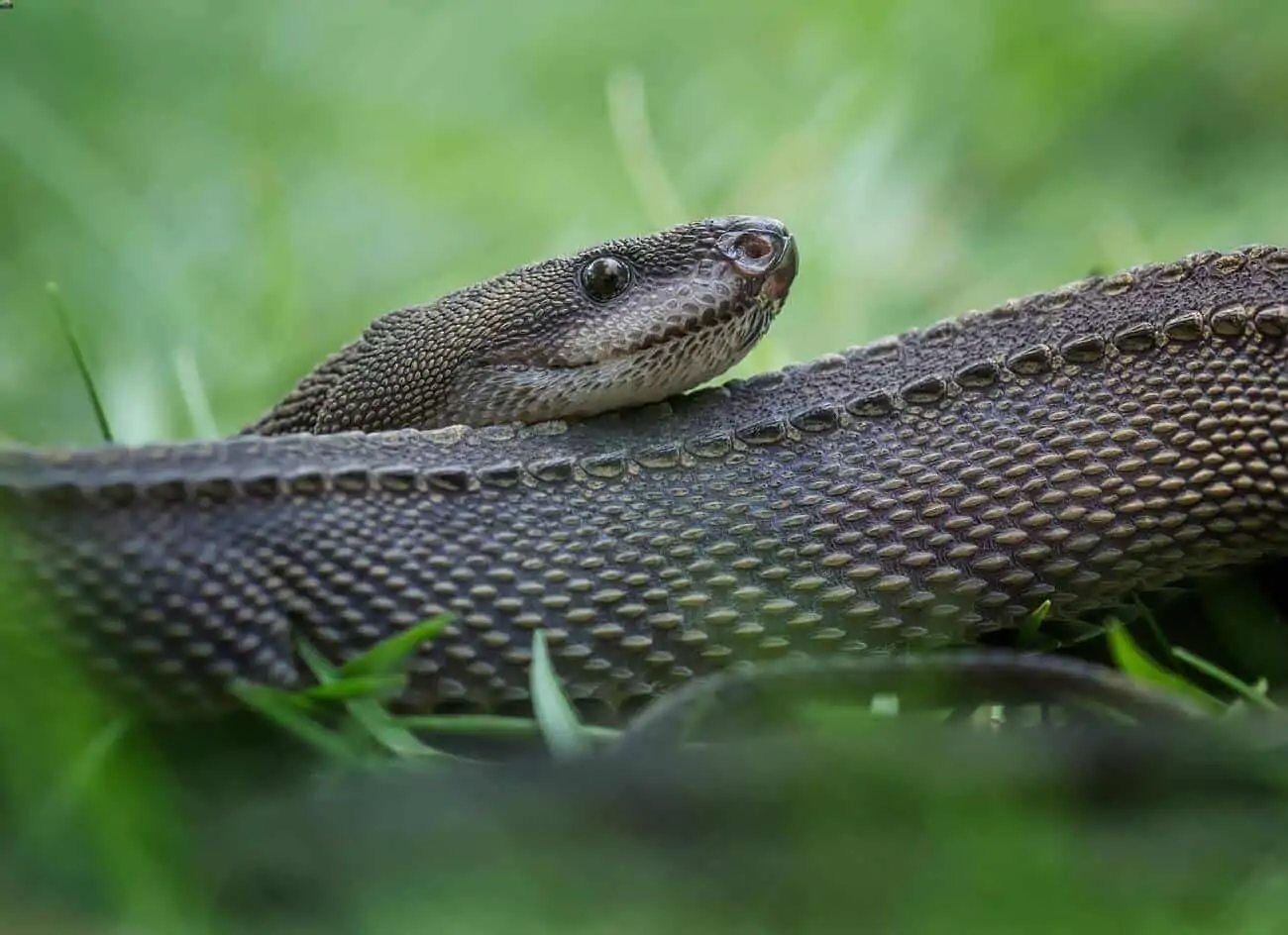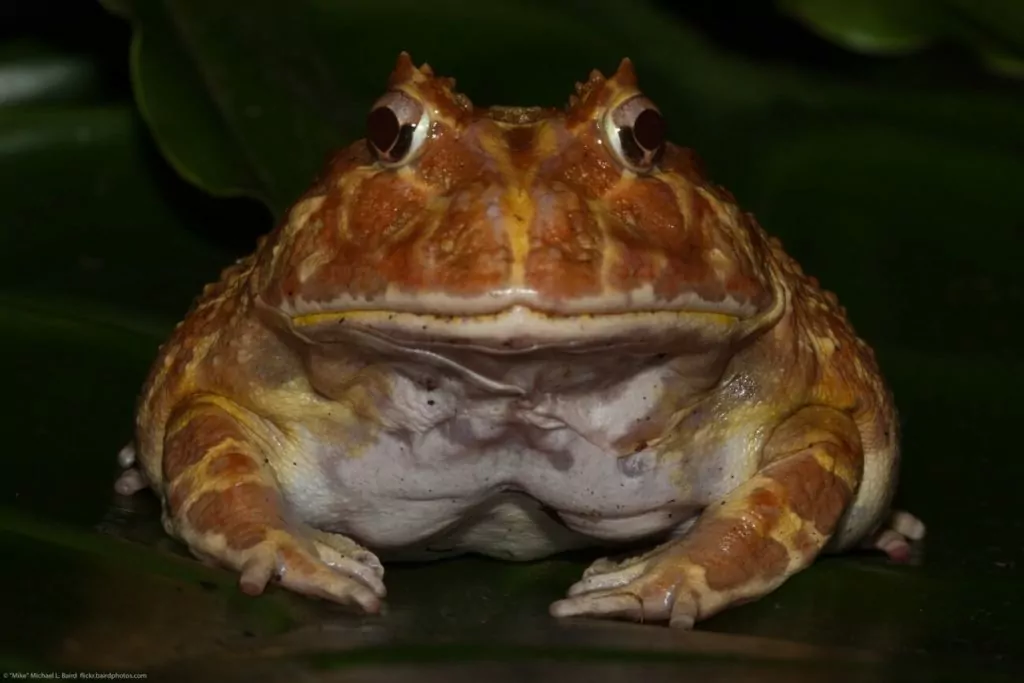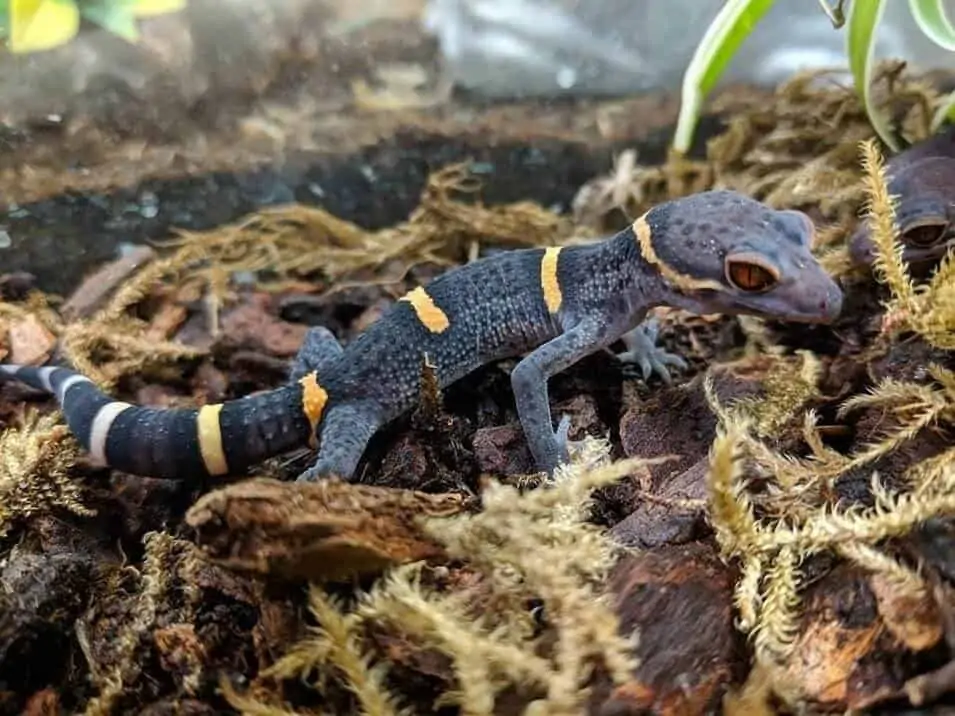Dragon snakes are a gorgeous and fascinating species that have interested reptile-lovers for years. Their unique appearance can’t be found anywhere else!
But very little is known about these snakes if you want to keep one as a pet. While some fundamental care guidelines have been established, the community is still learning about these uncommon reptiles.
In this guide we’ll go over what’s currently known about keeping dragon snakes as pets (and the species in general).
Table of Contents
Species Summary
The dragon snake (Xenodermus javanicus) is sometimes also referred to as the Javan mud snake or the rough-backed litter snake. In the wild, this snake can be found in countries like Malaysia, Thailand and on islands like Java and Borneo.
This is a snake that’s rather shrouded in mystery, and information about keeping pet dragon snakes is pretty sparse. It is known that dragon snakes require the most advanced knowledge of reptile husbandry, and only the most experienced reptile owners should try to care for one.
Appearance & Colors
The appearance of the dragon snake is the main reason why this snake is so popular with dedicated reptile collectors.
But their coloration (a plain gray with a white belly) is not what attracts reptile fans. What makes the dragon snake so desirable to enthusiasts is its unique scale arrangement.
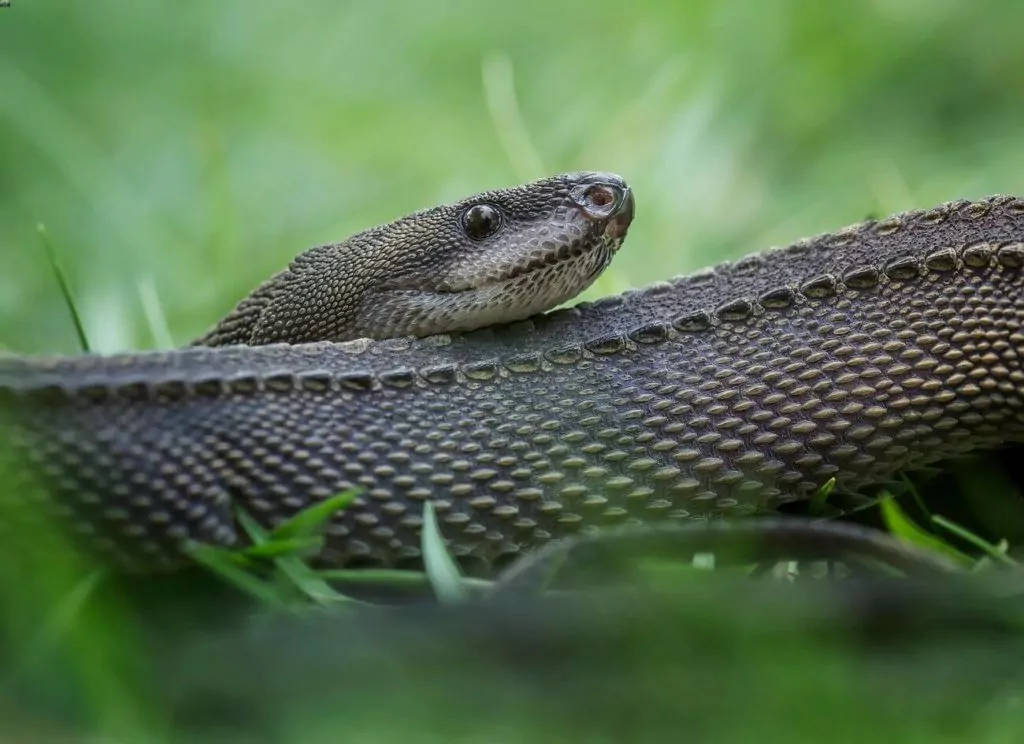
Unlike many other snakes, the dragon snake has three rows of keeled scales. Keeled scales differ from other scales in that they have a prominent ridge.
These rows of keeled scales, that run the dorsal length of the snake, resemble the ridges on a dragon’s back. It seems that Johannes Reinhardt, the man who first discovered this snake in 1836, noticed this similarity and gave this snake its name.
Lifespan
Pet dragon snakes tend to have a lifespan of roughly ten years. It’s worth pointing out that this is definitely a ballpark figure, because there is not too much information to go on.
These snakes usually don’t thrive in captivity (which is often due to an unprepared owner), so hard life expectancy estimates are pretty hard to come by.
Expert Tip: They are very sensitive snakes, so only the most meticulous care will give dragon snakes a chance to reach this full lifespan in captivity.
Average Size
The average size of a dragon snake is around 24 to 30 inches in length. This isn’t too large, which makes their size a secondary concern when it comes to keeping them in captivity.
There have been whispers of these snakes exceeding this length when kept as pets, but those instances are both rare and unconfirmed.
Dragon Snake Care
Caring for a dragon snake should be left to only the most experienced reptile caretakers. So few of them have been kept in captivity that not too much is known about successful care practices.
What is known is that they require very exact enclosure conditions, and they are quite particular about their food and the way it’s presented. Dragon snakes are easily stressed, and even the slightest variation from their requirements can result in serious health issues.
Even though they are non-venomous, they may even inflict a painful bite if they feel even the slightest bit threatened.
Enclosure Size & Dimensions
You’ll need to provide your dragon snake with an enclosure that is at least 14 by 10 by 9 inches.
It doesn’t really matter what kind of enclosure you use as long as it’s the minimum size. Some owners use glass terrariums, plastic bins or customized wooden enclosures. As long as it meets the snake’s requirements and has a secure lid, it will be fine.
Expert Tip: Just remember that dragon snakes need to be housed separately. Housing them together can cause unnecessary stress, and they may even become aggressive with each other.
What To Put In Their Habitat
Because dragon snakes are not commonly kept in captivity, there isn’t always a lot of information about their husbandry. This also applies to setting up their habitat within the enclosure.
However, we know that a choosing substrate is important (and we know some that work).Pick a substrate like sphagnum moss that will retain moisture but won’t get too wet. If mold builds up on the substrate, your dragon snake could become seriously ill.
Dragon snakes are totally nocturnal, and you’re going to have to provide a safe, dark place for them to hide in during the day. Some kind of reptile hide is the best. Plastic is easy to clean and keep mold-free, so many owners stick with that.
Temperature & Lighting
Here is where things can get a little bit unusual. Unlike other pet snakes, dragon snakes do not need a hot spot in the enclosure.
In fact, these snakes won’t tolerate much heat at all, and the enclosure should be kept between 72 and 77 degrees Fahrenheit. This is quite different from the required care practices of other pet snakes, so you’ll need to adjust!
Expert Tip: Because of this, it’s very important to have a reliable thermometer measuring the temperature inside of the enclosure. Dragon snakes will die if the temperature goes higher than 80 degrees Fahrenheit for more than an hour.
Humidity
In order to keep your dragon snake happy and healthy, you are going to have to keep the humidity level very high in the enclosure. In fact, a humidity level as high as 85 to 95 percent is required for these reptiles to thrive.
Since this is a very high level of humidity, you’ll need to rely on a proper habitat setup to maintain it. Using a good substrate can really help to hold in the amount of moisture that is needed to keep these levels consistent.
Misting the enclosure a few times a day will also help prevent the enclosure from drying out. Make this a habit!
Water
Dragon snakes need a consistent source of clean and fresh water in their enclosure.
They like to drink and soak in it, so you’ll need to provide them with a water area that’s big enough for them to curl up in. Some dragon snake owners use a plastic or ceramic bowl, while others feel that the water receptacle should be made of stone.
Expert Tip: No matter what you use, it should be kept immaculately clean. Replace the water often and clean out the bowl on a weekly basis. Failing to do this can result in bacteria and disease.
Dragon Snake Food & Diet
Feeding a dragon snake is one of the key points that makes caring for this snake so difficult. Dragon snakes are notoriously picky eaters, and owners are often hard-pressed to get the whole feeding routine figured out (most owners feed them at night).
Dragon snakes prefer to stick to their favorite food, but as a new dragon snake owner you will not know what that particular food item is. In the wild they eat tadpoles, frogs and fish, so it will be trial-and-error until you find out what the snake wants to eat.
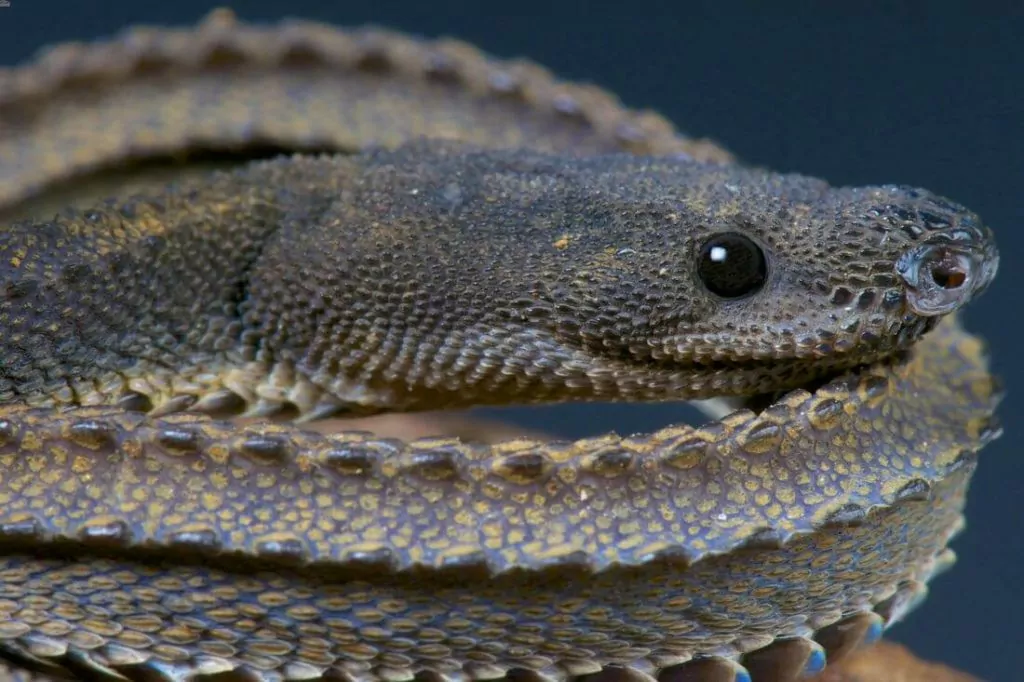
A new snake will need to settle in for a few days before you begin this process. Once this time period has passed, you can begin trying prey items one at a time.
Once you get the hang of what they like to eat, you can begin to follow an established routine. This consists of two fish every seven to ten days, or one frog every seven to ten days. Be patient, and you will soon get the hang of it!
Don’t be tempted to overfeed your dragon snake. They love to eat and can become obese very quickly (leading to health complications).
Potential Health Issues
Information about the potential health issues of the dragon snake is pretty hard to come by.
What we do know is that they are rather susceptible to skin irritations caused by an unclean or moldy enclosure. A clean living space is going to be critical for their long-term health, so be consistent with your cleanings!
Other health issues we know about include stress-related problems, obesity, parasites and a high sensitivity to heat.
Even veterinarians with experience handling exotics may not know too much about the dragon snake. Keeping your snake happy and healthy is going to be a combined effort with you and your vet.
Behavior & Temperament
Dragon snakes are non-venomous and not overly aggressive. They will bite on occasion, but their nature is to totally stiffen their bodies during times of stress or fear.
It’s best to handle these snakes as little as possible because too much stress can completely disrupt their feeding routine. When this species is scared it can really mess with their appetites, and they may even stop eating for an extended period of time.
Expert Tip: These snakes are purely nocturnal, and they will only hunt in absolute darkness. This is important to know for their feeding schedule, but also so you know when to watch for activity!
Handling Them
As mentioned above, dragon snakes do not like to be handled at all. The only time you should handle them is for health reasons, or if you need to move them.
They are really beautiful and interesting snakes, and the best thing for them is to be left alone. Attempting to handle them will only result in stress (which can compromise their health).
Conclusion
Dragon snakes are a unique and uncommon pet that have a lot to offer. But remember, owning one is hard work.
Due to their sensitive nature and the lack of information out there, there’s a lot of trial and error when it comes to successfully keeping this species as a pet.
As time goes on and the community learns more about the care requirements of this species we’ll make sure to add any additional information to this guide. If you’re an owner and have any tips you’d like to share, feel free to let us know!

